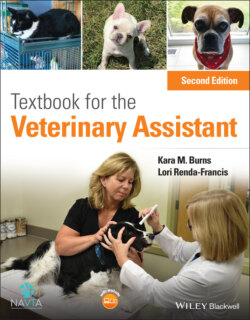Читать книгу Textbook for the Veterinary Assistant - Lori Renda-Francis - Страница 27
Anatomical directional terms
ОглавлениеDirectional terms should always be utilized because they accurately and concisely describe body locations as well as relationships of one body structure to another. Terms such as “up” and “down” or “forward” and “backward” should not be used as these terms can cause confusion among veterinary professionals. Consistent use of proper anatomical and directional terms ensures the clear and accurate communication of the intended message.
Directional terms and directional planes are references used to describe the position and direction of various body structures. Directions will generally refer to a relative location and not an absolute point. We must first understand the various anatomical planes utilized in veterinary medicine. The four basic planes are dorsal, median, sagittal, and transverse.
The dorsal plane is an imaginary line that divides the body into dorsal and ventral portions. The median plane is an imaginary line that extends directly down the middle of the body, dividing it into equal right and left portions (Figure 3.1). The sagittal plane is an imaginary line that divides the body into right and left unequal parts, and the transverse plane is an imaginary cross‐section that divides the body into cranial and caudal parts.
The terms below are used to describe direction or the position of a body part. We will begin with the basic directional terms.
The term cranial refers to the head portion of the animal’s body, while caudal refers to the tail portion of the body. For example, we might say that the tail is caudal to the head or the head is cranial to the tail.
The terms “anterior” and “posterior” are used to describe the front and rear ends of the body. Anterior refers to the front of the body and posterior refers to the rear end of the body (Figure 3.2). For example, if a laceration was near the tail of an animal, we might say that the laceration is located on the posterior portion of the body.
We stated that the median plane divides the body into equal right and left portions. The terms “medial” and “lateral” are used to describe the location as it relates to the midline. Medial is defined as nearer or toward the midline or median plane, and lateral is defined as farther from the midline or median plane or toward the side of the body (Figure 3.3).
The dorsal plane divides the body into dorsal and ventral portions. The terms “ventral” and “dorsal” are utilized to describe the location as it relates to the dorsal plane. Ventral is defined as pertaining to the belly or underside of the body, and dorsal is pertaining to the back of the animal or toward the spine. For example, the abdomen is ventral to the spinal column.
“Proximal” and “distal” are commonly used when referring to extremities, with the point of origin being the main body mass. Proximal is used to describe a structure nearer to the point of origin or closer to the body, and distal is used to describe a structure that is farther from the point of origin or away from the body (Figure 3.4). For example, the femur is proximal to the fibula.
Figure 3.1 Median plane.
Source: Courtesy of Dr Lori Renda‐Francis, LVT.
Figure 3.2 Anterior/posterior.
Source: Courtesy of Dr Lori Renda‐Francis, LVT.
Figure 3.3 Medial/lateral.
Source: Courtesy of Dr Lori Renda‐Francis, LVT.
Figure 3.4 Proximal/distal.
Source: Courtesy of Dr Lori Renda‐Francis, LVT.
The terms “palmar” and “plantar” are used when referring to the undersurface of the feet. Palmar is defined as the caudal surface of the forelimb below the carpus, and plantar is the caudal surface of the hindlimb below the tarsus (Figure 3.5).
“Internal” and “external” are used to describe a structure as it relates to the surface of the body. Internal refers to deep inside the body, and external refers to the outer surface of the body, which is more superficial.
Finally, the term rostral is defined as pertaining to the nose end of the head (Figure 3.6). For example, the nose is rostral to the eyes.
Figure 3.5 Anatomical terms.
Source: Courtesy of Dr Lori Renda‐Francis, LVT.
Figure 3.6 Rostral.
Source: Courtesy of Dr Lori Renda‐Francis, LVT.
